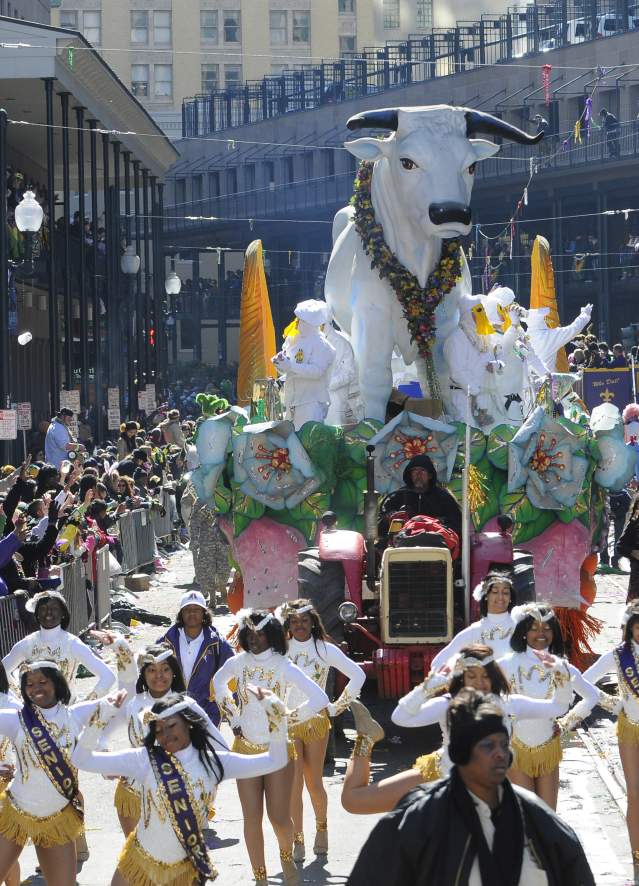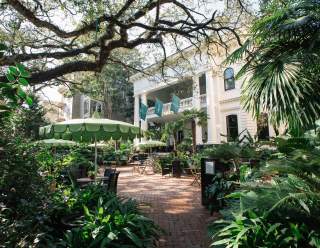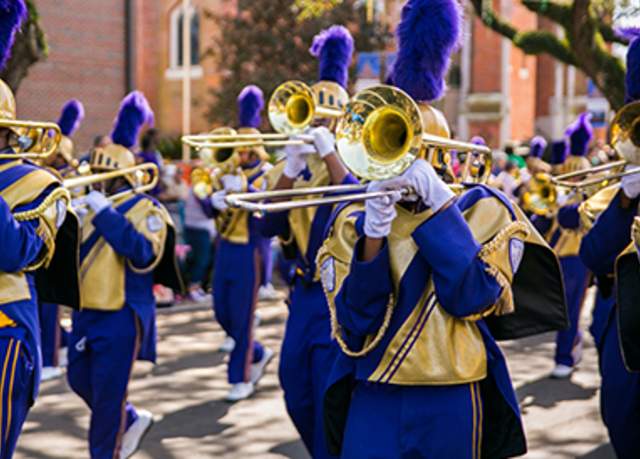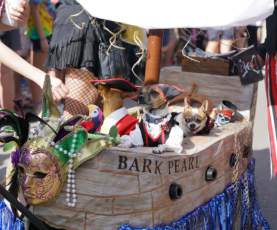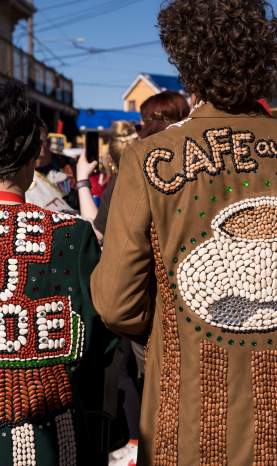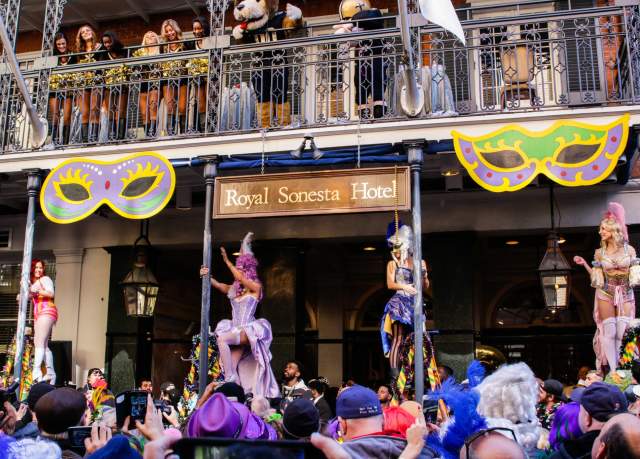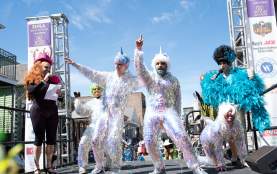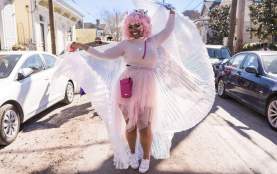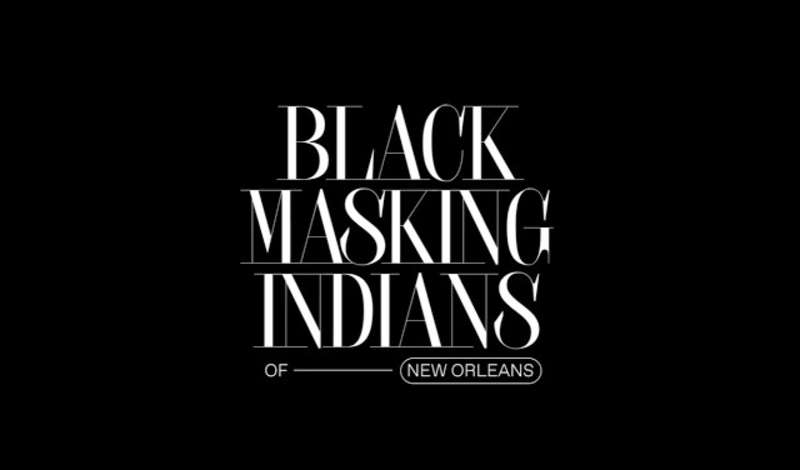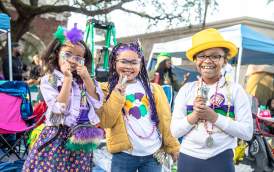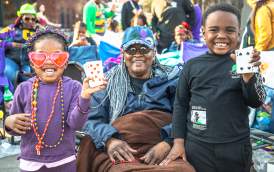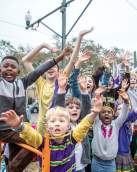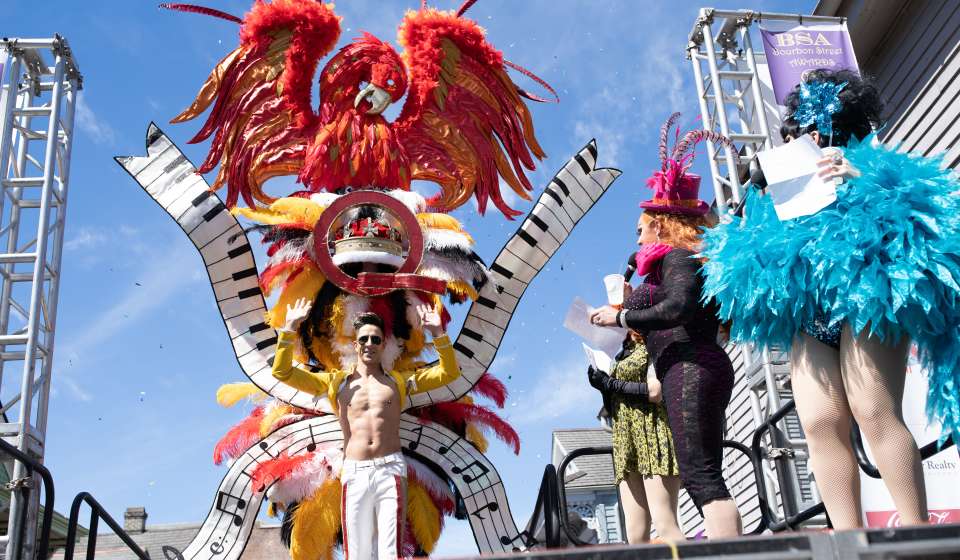The Ultimate Mardi Gras Guide
Mardi Gras is Tuesday, February 17, 2026
Jump To:
Mardi Gras History & Traditions | Parades & Krewes | Mardi Gras Logistics & Planning | Experiences & Cultural Highlights | Food & Drink | Final Tips
Mardi Gras At-A-Glance
The Basics of Mardi Gras
Mardi Gras is the biggest celebration in New Orleans, culminating on Fat Tuesday, the day before Ash Wednesday. Known for its spectacular parades, vibrant costumes, and deep-rooted traditions, this celebration is a bucket-list experience. Expect elaborate floats, marching bands, throws (ranging from beads and cups to hand-made collectables), king cake, and a lively atmosphere across the city.
When is Mardi Gras?
Every year, Mardi Gras season begins on Twelfth Night, which is January 6. Twelfth Night represents the Christian holy day of the Epiphany. The season, which represents a time of celebration before Christian Lent, lasts until Fat Tuesday. Fat Tuesday, or Mardi Gras Day, is February 17, 2026. Between January 6 and February 17, enjoy parades, king cake, community celebrations, and more. For a list of future Mardi Gras Day dates, see here.
Where in New Orleans can I experience Mardi Gras?
Honestly? Everywhere across the city. From neighborhood second lines to the major parade routes, Mardi Gras touches pretty much every part of New Orleans in one way or another during Carnival Season. When it comes to parades, the main route runs down the length of Saint Charles Avenue–parades begin rolling on Napoleon and Tchoupitoulas, before turning down St. Charles towards Downtown before making a final turn on Canal Street towards the river. But there are variations in parade routes, so it’s best to check maps for individual krewes to find out the best place to watch. Beyond parades, you’ll find celebrations and gatherings in the French Quarter, Marigny, Bywater, Mid-City, and beyond.
What can I expect at Mardi Gras?
All of that can vary depending on the type of Mardi Gras you want to experience. As a general rule though, expect parades, masked riders, signature throws (from the bedazzled shoes of Muses to the sought-after coconuts at Zulu), live music, and non-stop revelry in many different forms.

An Experience Like None Other Stay In New Orleans
New Orleans Hotels and B&Bs give you something wonderful to come home to.


The History & Traditions of Mardi Gras
Mardi Gras has been celebrated in Louisiana since the 18th century, brought by French settlers. Today’s traditions stem from European carnival customs mixed with local culture, creating a uniquely New Orleans spectacle. We’ll get into most of these later, but here are the key traditions at a glance:
Krewes & Parades
Social clubs, called krewes, organize the parades and balls. Rex and Zulu are the most famous krewes on Mardi Gras Day, while Endymion, Bacchus, and Muses highlight the weekend before.
Masking & Costuming
Float riders are required by law to wear masks, a throwback to the tradition of disguising oneself to blur social lines. As a spectator, costumes aren’t required, but you’ll find that, especially on Mardi Gras Day, you’ll want to don some type of festive attire to fit in with the spirit of the city.
Black Masking Indians
Also called Mardi Gras Indians, tribes made up of Black New Orleanians create stunning hand-sewn suits and hold neighborhood gatherings.
Flambeaux
Beginning in 1857, flambeauxs were used to light the Mardi Gras parade. They are still used in parades today as tradition. A flambeaux is an iron pole that lights fire on either side of it. They are carried by brave walkers, who are thrown change as a thank you. More information can be found here.
King Cake
A (typically) sweet pastry with a tiny plastic baby hidden inside; whoever finds it must buy the next cake. Again, we’ll get more into this later.

What is the History of Mardi Gras?
Mardi Gras originated in New Orleans the day Iberville stood on our land in 1699. Since then, balls have become a tradition of the season to represent members of society. From the past to the present, Mardi Gras is full of traditions.
Mardi Gras balls began in the 1700s and still exist today. At the Twelfth Night ball, a king cake was cut, and whoever found the bean (a precursor to today’s baby) inside would host the next ball. This would continue until Mardi Gras evening. Numerous balls still exist today, although they are often affiliated with various parades, organizations, or krewes. The first ball was held in 1857 by the Mistick Krewe of Comus. Comus hosted the first parade, followed by Rex in 1872, which debuted the king of Mardi Gras. The Rex parade gave Mardi Gras the official colors of purple to represent justice, green to represent faith, and gold to represent power. The three colors were to represent the “king.”
In 1872, the city of New Orleans was struggling through years of Reconstruction. To help the city and promote tourism, proclamations of Mardi Gras were posted at train stations throughout the country. Rex commanded his subjects to gather and celebrate Carnival in New Orleans. From there on, Mardi Gras became a sought-after tourist attraction.
For more in-depth information on Mardi Gras history and traditions, see here. You can visit many Mardi Gras museums year-round as well.

Mardi Gras Parades & Krewes
Parades begin the weeks before Fat Tuesday, with the most famous ones rolling the final days leading up to Mardi Gras.
What are Mardi Gras Krewes?
Krewes are the heart of Mardi Gras celebrations in New Orleans. These carnival clubs, which are chartered as non-profit organizations, represent various groups that celebrate the season through elaborate parades and balls. Each krewe has its own unique history, traditions, and membership structure - some are exclusively men's or women's organizations, while others welcome everyone. Many families have belonged to their krewes for generations.
The leadership structure of each krewe typically includes a captain, who holds the honored position of leading the organization. Krewes also feature courts composed of a king, queen, maids, and dukes, with these roles typically changing annually. While all krewe members support the organization, not everyone participates directly in the parades.
Krewe parades are known for their creative themes, which change yearly and draw inspiration from diverse sources including history, mythology, current events, entertainment, and popular culture. Some of the most celebrated parades are particularly renowned for their political satire and comedy. The items thrown to parade-goers (known as "throws") often reflect either the year's theme or the krewe's traditional symbols.
These organizations are sustained through member dues, merchandise sales, and various fundraising initiatives. Beyond their carnival activities, most krewes are actively involved in charitable work within their communities.
Mardi Gras Bucket List
Already been to Mardi Gras in New Orleans? Think you can scratch it off your bucket list? Not so fast! Before you say you’ve seen it all, here are some…
What are the Major Krewes and Their Parade Days?
Focusing just on the larger parades leading up to Mardi Gras Day, you’ll find:
-
Thursday – Krewe of Muses (TLDR: all female, shoes are the signature throw)
- Friday – Krewe of Hermes and Krewe d’Etat
- Saturday – Krewe of Endymion (TLDR: largest parade, known for extravagant floats)
- Sunday – Krewe of Bacchus (TLDR: celebrity monarchs and signature beads)
- Monday (Lundi Gras) – Krewe of Orpheus (TLDR: co-founded by Harry Connick, Jr.)
- Tuesday (Mardi Gras Day) – Krewe of Zulu (TLDR: one of the oldest majority Black krewes) and Krewe of Rex (TLDR: the symbolic King of Carnival)
What is Rex?
The Rex Organization was founded in 1872, and hosted the second official parade behind Comus. It is the longest parading organization, as Comus no longer rides. The organization is credited for creating Mardi Gras royalty: Rex and his queen. Rex means king so he is known as the King of Carnival. You can spot the homes of past kings and queens of carnival by the large Rex flags hung outside. The organization is also credited with naming Mardi Gras’ official colors of purple, green, and gold, and the official royal anthem, “If I Ever Cease to Love.” The song is heard at the Rex ball, which officially closes out Mardi Gras each year. Attendance to the ball is by invitation only, but the ball can also be watched on New Orleans’ local PBS channel (which also offers a live-stream of their website). More information on the Rex Organization can be found here.

What is Zulu?
Zulu is a Social Aid and Pleasure Club that dates back to the early 1900s. Social aid and pleasure clubs were a form of financial help for members of the African American community. The club went on to create a Mardi Gras day parade that first rode in 1915, but their major route of St. Charles Avenue and Canal Street did not appear until 1968. Before then, the parade could only travel through “back streets” in African American neighborhoods. The official costume of all riding members of Zulu is black face paint, wigs, and grass skirts. From the beginning, the members threw coconuts, and today, they are highly sought after - although to prevent head injuries, coconuts must now be handed down instead of thrown into crowds. They were first painted gold, silver, or black to represent gold, silver, and coal, but today, they are hand-painted in elaborate colors and designs. No two coconuts are alike! The parade’s success over the years is due to the dedication of their members and community involvement. They host a Lundi Gras celebration to prepare for the big day. Zulu rolls at 8 a.m. on Mardi Gras Day, so if you want to catch the whole thing (and for a better chance at a coconut), plan to get there early for a good spot. For more information on the history of Zulu, see here.
Are There Smaller Neighborhood Celebrations and Parades?
Yes! Mardi Gras is truly a citywide celebration, and you’ll find everything from quirky, satirical floats pulled by horses in Krewe du Vieux (warning: the themes of this parade are definitely risque and meant for adults only), to the North Side Skull and Bones Gang who roam the streets of the Treme beginning at dawn every Mardi Gras morning. Other notable favorites are the tiny shoebox floats of the Marigny-based ‘tit Rex parade and the delightfully nerdy Intergalactic Krewe of Chewbacchus. There’s truly something for everyone–even dogs, who parade the streets of the French Quarter alongside their owners as part of the Mystic Krewe of Barkus.
Planning Your Mardi Gras Trip
From when to come to where to stay–and even where to use the restroom. Here are the main logistics you need to know to plan a trip to Mardi Gras.
When is the best time to go to Mardi Gras?
It is fun to be in New Orleans throughout the Mardi Gras season, but the biggest celebrations and parades begin one week before Mardi Gras Day. A marathon of parades and super-krewes roll every single night. Prior to that week, various parades roll in neighborhoods across the city on weekends-- beginning on Twelfth Night in January. Flights and hotels fill up fast, so plan your trip ASAP!
Mardi Gras Hotel Packages
Find hotel rooms and packages to make your Mardi Gras stay unforgettable.
Where Should I Stay During Mardi Gras?
Where you stay during Mardi Gras depends on what you’re interested in seeing and doing. Parades roll in various neighborhoods, but the main route is from Napoleon Avenue down Saint Charles Avenue in the Uptown Neighborhood to Canal Street in the Central Business District (just on the edge of the French Quarter). It is difficult to get around during Mardi Gras, so walking or biking is your best bet. You should look into a hotel or bed and breakfast along the route– St. Charles Avenue or Canal Street are good places to start, but due to their proximity, they WILL fill up fast.
If you're coming with your family, the Uptown neighborhood is recommended for lodging and parade viewing. Some hotels closer to downtown offer balcony viewing or stands for guests.
In general, you’ll find that the French Quarter is close to the action but can get crowded (and is better for adults). Hotels around Uptown and the Garden District will offer a more relaxed atmosphere while still being close to the parade route, and hotels in the Central Business District and Warehouse District are convenient for both parade access and nightlife.
How Should I Plan to Get Around the City During Mardi Gras?
Walking is best–public transportation such as buses and streetcars run, but their routes may be limited due to parades and they’ll oftentimes be crowded with other paradegoers. Rideshares are another good option, but like with any major event, plan for surge pricing. Biking is another great option–you can rent bikes or find the Blue Bikes at different points around the city.
Another important thing to consider during Mardi Gras are restrooms. Restrooms are hard to find during parades, although some port-a-potties offer a toilet for a fee. Having a room close to the route is a bonus for this reason. You can also usually find bathrooms at churches and schools along the routes for a small fee. They’ll also often have snacks, water, and other concessions for sale if little ones (or adults) get hungry.

Do I need tickets to Mardi Gras?
Mardi Gras is a free event! No tickets are needed to view parades. For this year's Mardi Gras parade schedule, see here. However, balls are invitation-only or ticketed. You can also buy passes to watch parades on grandstands, located all along the route. While this isn’t as necessary further Uptown along the route, viewing stands can be helpful if you’re staying downtown and watching parades close to your hotel. Check with your hotel and see what they recommend.
Mardi Gras Experiences & Cultural Highlights
Mardi Gras is one of the most unique experiences on the planet. From costuming to one-of-a-kind customs, here are some of the highlights you need to know before you go
What is Mardi Gras Masking? Do people costume?
Masking is a tradition during Mardi Gras. Masks were first worn to escape society and class constraints. Today, float-riders are required to wear masks by law to keep in tradition and mystery of who is in which krewe. Float-riders often wear a costume as well that matches their float’s theme.
Parade-goers may be seen wearing masks as well, although that is not necessary. Costumes, however, are very common for parade-goers. Whether you’re decked out in purple, green and gold or just something fun, your costume will add to the celebration. Costumes are especially encouraged on Fat Tuesday. Otherwise, dress comfortably in closed-toe shoes! Visit our local costume shops for Carnival-inspired fashion.
What is Lundi Gras?
Lundi Gras, which means Fat Monday in French, is the day before Mardi Gras day. Thus, Lundi Gras Day is February 16, 2026. Some parades roll that night, including Proteus and Orpheus, while the day is often filled with festive lunches and celebrations, including the wonderfully creative Red Beans Parade. Zulu and Rex historically meet on this day and host various celebrations. To read more about Lundi Gras traditions, click here.
Who are the Black Masking Mardi Gras Indians?
One of the most mysterious, fascinating, and colorful pieces of New Orleans’ cultural quilt belongs to Mardi Gras Indians. A unique and historic subculture of New Orleans, Mardi Gras Indians and their traditions date back to the 1800s when Native Americans helped shield runaway slaves. Mardis Gras Indian culture is influenced by both ancestral enslaved Africans and the friendship forged with Native Americans. Catch the Mardi Gras Indians parading by foot on Mardi Gras Day as they debut their elaborate handmade suits.
Is Mardi Gras family-friendly?
Locals grow up going to Mardi Gras--it is absolutely family-friendly! The Uptown section between Napoleon Avenue and Jackson Avenue is recommended for children. Although, there are some stands downtown at hotels that are suited for children as well. You can view our Mardi Gras for Families guide for more information.
Is Mardi Gras LGBTQ-Friendly?
Mardi Gras is incredibly open and welcoming - it’s a citywide celebration of everything that makes New Orleans great. The LGBTQ community has put their own stamp on Mardi Gras with LGBTQ krewes, balls, and organizations. The Bourbon Street Awards, named the most famous drag queen contest in America, takes place every Mardi Gras Day and is a sight to see! To be closer to the action, LGBTQ visitors may want to book accommodations in the French Quarter, Marigny, or Bywater.
Food & Drink at Mardi Gras
New Orleans is known for its food and cocktails, and Mardi Gras is no exception.
What is king cake?
King Cake is the official food of Mardi Gras. The festive Mardi Gras dessert is eaten for breakfast, afternoon snacks, and throughout the parades. The name comes from the Biblical story of the three kings that bring gifts to baby Jesus. It is a blend of coffee cake and a cinnamon roll with purple, green, and gold icing or sugar. Sometimes, they are also filled with cream or fruit. Within the cake, a plastic king cake baby is hidden for fun. Tradition says that whoever finds the baby has to buy the next king cake!
King cakes are usually available to purchase beginning on Twelfth Night until Mardi Gras day. However, some bakeries have begun to sell them year-round. . For a list of where to purchase one or how to make one, see here.
Are there Mardi Gras drinks?
In New Orleans, there is no open container law. Grab a drink to-go and hit the streets! Keep in mind, no glass bottles though. The plastic cups thrown at parades are great to use when you're out and about. If looking for a place to grab a beer or cocktail along the parade route, look no further than here.
Final Tips for Enjoying Mardi Gras
Some parting words of wisdom for making the most of your Mardi Gras experience.
Get There Early
Front-row parade spots fill up quickly
Respect the Ladders
Ladder legs must be six feet back from the curb. Because it’s primarily families using ladders, be mindful of small children.
Bring Cash
While many places take cards (or at least tap-to-pay), it’s still never a bad idea to have cash on hand for purchasing beverages, snacks along the route, or paying for bathroom access.
Watch Your Belongings
Mardi Gras is full of people–and in any crowded situation, it’s always smart to have your belongings secured. We’re fans of cross-body bags for ease of personal access.
Mardi Gras is an unforgettable experience–embrace the chaos, catch some beads, and let the good times roll. For more information on Mardi Gras, view our Mardi Gras Bucket List and FAQs. To get prepared, see our Mardi Gras Lingo. And explore more of everything that goes into making Mardi Gras in the video below:
